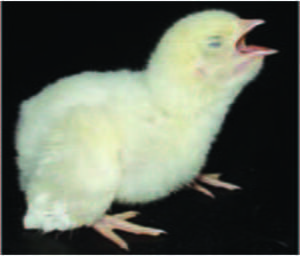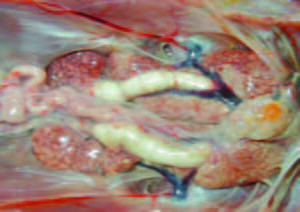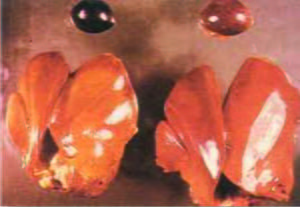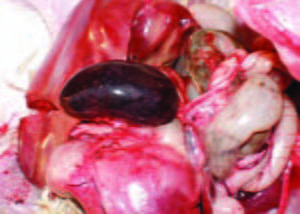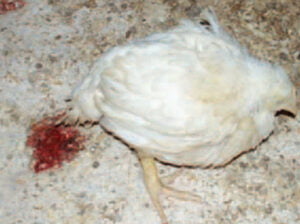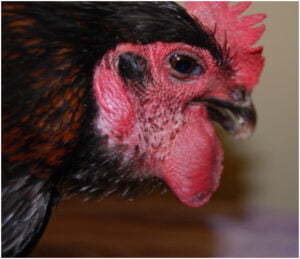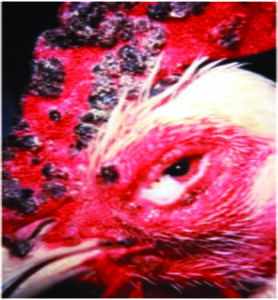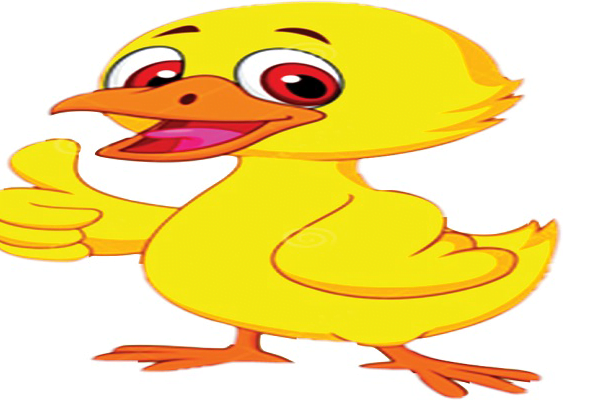Poultry Disease Prevention during rainy season
Dr. R.Jayanthi1 and Dr.M.Boopathy Raja2
1Ph.D Scholar, Department of Livestock Products Technology (Meat Science), Madras Veterinary College, Chennai-600 007
2Assistant Professor, Dept. of Veterinary and Animal Husbandry Extension Education, Veterinary College and Research Institute, Ramayanpatti, Tirunelveli-627 358
Introduction:
Seasonal variation is one of the major non-genetic factors that affect livestock production. Poultry and other livestock animals consume less feed and drink more water in the hot season in order to cool their body while during the rainy/winter season, they increase their level of feed intake to generate heat and stay warm.The rainy season is usually with an increase in relative humidity and a reduction in temperature. The rainfall affects both the quality and quantity of feed intake in poultry while wind speed has an impact on the outbreak of diseases. These changes affect the production of birds, most especially in laying birds, as the egg production is reduced in extremely cold or hot weather. Some poultry diseases are prevalent in the wet, rainy or winter seasons because the onset of rain favours the proliferation and spread of causative organisms of particular diseases and parasites. Hence, most of the poultry farmers experience high morbidity and mortality during the rainy season.
Certain poultry diseases which are very important in poultry production, common in rainy season and that can be prevented. They are
1. Aspergillosis, 2.Bacterial diseases, 3. Coccidiosis, 4. Fowl cholera, 5. Fowl pox
1. ASPERGILLOSIS
Aspergillosis is the disease caused by Aspergillusfumigatus in poultry. Due to the high humidity during rainy season the feeds and litter materials are creating a favourable environment for fungus to grow and thrive. The spores of Aspergillus are inhaled by the birds and these spores develop into lesions and filling the lungs further causing respiratory problems or discomforts.
Acute form: Young chicks are generally affected by an acute form of Aspergillosisand results in high morbidity and mortality. Commencement of infection is very quick and usually develops within a week. Most affected birds will die within a few days without any emergency veterinary care.
The most common signs: Lethargy, depression, loss of appetite, difficulty in breathing, and cyanosis (bluish/purplish comb).
Chronic form: Older birds are affected in chronic form. This is usually very subtle in onset, and it may take several weeks or months to develop. Most of the birds are with the history of malnutrition, stress, concurrent illness, or prolonged antibiotic/corticosteroid use. The entire course of the disease ranges from less than 1 week to over 6 weeks in duration.
The most common signs: Weight loss, reduced appetite, exercise intolerance, increased respiratory rate, changes in vocalization (voice), often more apparent in roosters, audible respiratory sounds, tail bobbing, open-mouthed breathing.
Diagnosis:A presumptive diagnosis of aspergillosis can usually be made based on the history of the flock, clinical signs, and physical examination. Samples can be analysed for the presence of aspergillus.
Prevention of Aspergillosis: Dry, good quality litter and feed and hygiene will help in the prevention of aspergillosis. Antifungal drugs such as Thiabendazole or Nystatin can be used in feed.
Treatment: Usually there is no treatment. Environmental spraying with effective antifungal, antiseptic may help reduce the challenge. Amphotericin B and Nystatin have been used in high-value birds.
2. BACTERIAL DISEASES:
Salmonellosis, Escherichia coli and Pullorum Disease (Bacillary White Diarrhoea): These bacterial diseases affect birds of all ages. They are endemic in farms or pens with poor sanitation, such as is seen when wet litter is allowed to stay for a long time. They affect the digestive system of the infected birds.
Salmonellosis
Pullorum disease
E.coli infection
Diagnosis:
* Severe diarrhoea
* Loss of appetite
* Depression and emaciation
* Chicks suffer omphalitis
* White pasty diarrhoea in pullorum disease
* Huddling together and laboured breathing
Prevention, Control and Treatment
Salmonellosis, E. coli and Pullorum diseases can be treated by administering a broad-spectrum antibiotic to the flock. High-level farm/pen hygiene and sanitation must be maintained. Biosecurity measures should be in place. contaminated feeds sCould be avoided.
3.COCCIDIOSIS
Coccidiosis is caused by a protozoan Eimeriasp in poultry which affects various sites in the intestine. The infectious process is fast (4–7 days) and is characterized by parasite replication in host cells with extensive damage to the intestinal mucosa. Poultry coccidia are generally host-specific, and the different species parasitize specific parts of the intestine. However, in game birds, including quail, the coccidia may parasitize the entire intestinal tract. Coccidia are distributed worldwide in poultry, game birds reared in captivity, and wild birds.The wet litter and the hot pen temperature commonly observed in the rainy season favours the sporulation of the coccidian oocyst and therefore, the outbreak of coccidiosis.
Diagnosis:
Clinically, bloody faeces, ruffled feathers, anaemia, and somnolence are observed. Other signs of coccidiosis range from decreased growth rate to a high percentage of visibly sick birds, severe diarrhea, and high mortality. Feed and water consumption are depressed. Weight loss, development of culls, decreased egg production, and increased mortality may accompany outbreaks. Mild infections of intestinal species, which would otherwise be classed as subclinical, may cause depigmentation and potentially lead to secondary infection, particularly Clostridium spp infection. Survivors of severe infections recover in 10–14 days but may never recover lost performance.
The lesions are almost entirely in the intestinal tract and often have a distinctive location and appearance that is useful in diagnosis.
Prevention:
* It is good to ensure that the poultry house is generally clean and dry.
* Ensure water is clean and fresh. Keep feeding areas clean and dry.
* Ensure the birds have enough space i.e. overcrowding should be prevented as it is a predisposing factor for coccidiosis. Chickens need an average of a square meter for 3-5 birds.
* If the chicks have not been vaccinated against coccidiosis, provide medicated starter feed for them. Anticoccidial medication should be given to the chicks at around 12 days of age (this might vary depending on the vaccination schedule being followed).
* An all-in all-out method should be employed on the farm in order to prevent a horizontal transfer of infection. If this method is not feasible, keep the new batch quarantined for a minimum of two weeks, for the protection of the current stock.
Treatment:
Once coccidiosis is diagnosed in a flock, all the birds need to be treated. Also, the litter needs to be changed so that birds do not pick up the sporulatedoocyst from the droppings of affected birds. Common anticoccidial drugsinclude; Amprolium, toltrazuril, sulfaquinoxaline etc. can be used to treat the birds.
4. FOWL CHOLERA
Fowl Cholera is a bacterial disease that affects birds of age 6 weeks old and above. The bacterium responsible for this is Pasteurellamultocida. It is highly contagious and mortality in acute cases is high. The causative organism is spread readily during the rainy season because wet litter serves as a habitat of numerous micro organisms.
Diagnosis:
In acute cases, birds that appear healthy and die suddenly while in chronic cases the affected birds show the following symptoms:
• Yellow, green or grey diarrhoea
• Loss of appetite
• Laboured breathing
• Drooped wings and tail feathers
• Ruffled feathers
• Swelling of the leg joints, sinuses, wattle and foot pad
• Twisting of the neck (torticolis)
• Discharge from the nostril or beak
Prevention, Control and Treatment
Fowl cholera can be treated using sulfa drugs, tetracycline, and erythromycin. Poultry birds can be vaccinated against fowl cholera by administering a fowl cholera vaccine. Maintain proper hygiene and sanitation. Practice a high level of biosecurity and prevent rodents, wild birds, and other animals.
5.FOWL POX
Fowl pox is a highly contagious disease that affects poultry at any age. It is caused by poxvirus transmitted by mostly mosquitoes and other blood-sucking insects. Since the mosquitoes are being the vector, that breed well during the wet season due to the abundance of stagnant water. Also, the incidence of wet litter becomes apparent when poultry houses are not adequately shielded from rain. This leads to the development of wet liter which then predisposes to fly problems in the pen.
Diagnosis:
Fowl pox leads to the development of round lesions with scabby centers on the skin of the birds. The majority of the skin lesions are located on the wattle, face, comb, and some are occasionally located on the legs. This disease also affects the mouth and windpipe linings. The lesions that are formed in the throat can develop to the extent of blocking the throat and it could eventually lead to death as a result of suffocation. Lesions on the face can extend to the eyes, causing temporary or permanent blindness of the affected bird.
Prevention:
The mechanical carriers of fowl pox are mosquitoes. So it is advisable to reduce the mosquitoes around the farm and environment. Ordinary sanitation and management practices will not prevent this disease, so vaccination is often the solution. It is recommended to vaccinate chickens and turkeys such as breeders, egg layers, and those that are highly susceptible to fowl pox. Live fowlpox vaccine is administered in the wing web of birds within age 6 and 10 weeks. If aggressive pecking is controlled among birds, skin damage which fowl pox causes is reduced.
Treatment:
Unfortunately, there is no treatment for fowl pox. But as long as a diseased bird is eating and drinking, it will recover from the disease in about two weeks or more with low mortality rate. When a bird recovers successfully from fowlpox, it is immune to the disease permanently.
